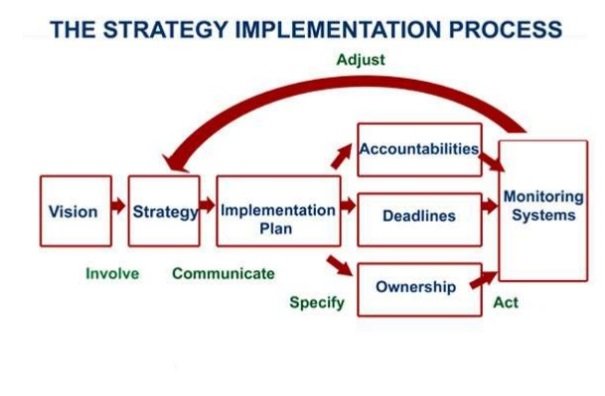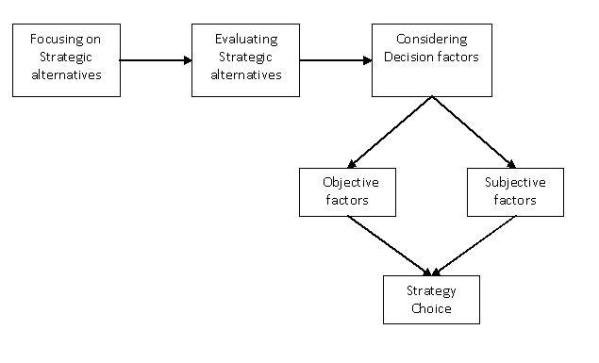Strategic Management, Objectives, Nature, Scope, Process
Strategic Management is a comprehensive approach to planning, monitoring, analyzing, and assessing an organization’s necessary actions to achieve its objectives and long-term goals. It involves setting priorities, mobilizing resources, and aligning employees and other stakeholders around a common vision. The process begins with identifying the organization’s current position, followed by developing and implementing strategies aimed at enhancing competitive advantage. Strategic management emphasizes adapting to external environmental changes and internal shifts to maintain a firm’s strategic fit. It includes continuous assessment and feedback loops to refine strategies over time. Ultimately, strategic management helps organizations ensure their actions are aligned with their mission, optimize performance, and sustain competitive positioning in the marketplace.
Objectives of Strategic Management:
-
Defining the Mission and Vision:
Establishing clear mission and vision statements to guide the organization’s direction and decision-making processes.
-
Setting Long-Term Goals:
Developing specific, measurable, and achievable long-term objectives that align with the mission and vision of the organization.
-
Analyzing Competitive Environments:
Conducting thorough analyses of the competitive landscape using tools like SWOT (Strengths, Weaknesses, Opportunities, Threats) and PESTLE (Political, Economic, Social, Technological, Legal, and Environmental) to identify external opportunities and threats.
-
Resource Allocation:
Efficiently allocating resources including capital, personnel, and time to maximize the effectiveness of the organization’s strategies.
-
Performance Improvement:
Implementing strategies aimed at improving operational efficiency and effectiveness, thereby enhancing the overall performance of the organization.
-
Risk Management:
Identifying potential risks in strategic decisions and creating mitigation strategies to manage those risks effectively.
-
Ensuring Organizational Flexibility:
Maintaining flexibility in management practices to quickly adapt to changes in the external environment or internal operations, ensuring the organization can swiftly respond to new challenges and opportunities.
Nature of Strategic Management:
-
Dynamic Process:
Strategic management is not a one-time action but a dynamic process that involves continuous analysis, planning, and adjustment to adapt to changing external and internal conditions.
-
Integrative Framework:
It integrates various aspects of an organization, from marketing and operations to finance and human resources, ensuring that all parts work together towards achieving the organization’s objectives.
-
Long-term Orientation:
While it can involve short-term actions and tactics, strategic management primarily focuses on long-term goals and sustainability, looking ahead to future positioning and success.
-
Complex Decision Making:
Strategic management involves complex decision-making that considers both external market conditions and internal capabilities, requiring thorough analysis and foresight.
-
Multidisciplinary Approach:
It draws on various academic disciplines and practical considerations, including economics, sociology, psychology, and quantitative methods, to inform strategic decisions.
-
Top Management Involvement:
It typically involves high levels of management, especially top executives and the board of directors, reflecting its importance to the overall health and direction of the organization.
-
Goal-Oriented Process:
The entire process is centered around achieving predefined organizational goals, whether they are related to market position, innovation, profitability, or other strategic priorities.
Scope of Strategic Management:
-
Strategy Formulation:
This involves the development of strategic visions, setting objectives, assessing internal and external environments, and creating various strategic alternatives. Strategy formulation requires a deep analysis of the strengths, weaknesses, opportunities, and threats (SWOT) a company faces.
-
Strategy Implementation:
Also known as strategy execution, this involves putting the formulated strategies into action. This includes designing the organization’s structure, allocating resources, developing decision-making processes, and managing human resources to execute the strategies effectively.
-
Strategy Evaluation and Control:
Continuously monitoring the execution of strategic plans is crucial. This involves setting benchmarks, measuring performance, and making necessary adjustments to the strategies or their implementation to correct deviations and adapt to new conditions.
-
Environmental Scanning:
This refers to the process of collecting information about the external environment (market trends, economic conditions, technological changes, and socio-political factors) as well as internal performance factors. This scanning influences strategic decisions by providing critical data needed for effective planning.
-
Decision Making:
Strategic management enhances decision-making capabilities by providing a structured framework that helps managers evaluate options and predict their outcomes. This can involve high-level, complex decisions that affect the entire organization.
-
Resource Allocation:
Effective strategic management involves determining where and how an organization’s resources (capital, personnel, technology, etc.) are allocated to achieve the optimal impact and strategic goals.
-
Corporate Governance:
It encompasses the mechanisms, processes, and relations by which corporations are controlled and directed. Strategic management helps in aligning corporate governance with the long-term goals and ethical standards of the organization.
-
Balancing Operational and Strategic Demands:
Strategic management ensures that the operational pressures of the present do not overshadow the strategic goals of the future. This balance is crucial for sustainable growth and competitiveness.
-
Stakeholder Management:
Understanding and managing relationships with all stakeholders, including investors, employees, customers, and communities, to align their expectations with the strategic objectives of the organization.
-
Innovation Management:
Encourages and facilitates innovation within the organization to maintain a competitive edge. This includes managing new ideas, products, services, and processes.
Process of Strategic Management:
The process of strategic management involves a series of integrated steps that help an organization align its mission with its strategic goals by adapting to the environment and optimizing internal capabilities.
-
Setting the Mission and Objectives:
The process begins by defining the organization’s mission, which outlines its purpose or reason for existence. Alongside this, strategic objectives are set, which are specific goals that the organization aims to achieve in the long term.
-
Environmental Scanning:
This step involves the systematic analysis of the external environment (opportunities and threats) and the internal environment (strengths and weaknesses). Tools like PESTLE (Political, Economic, Social, Technological, Legal, Environmental) analysis for external factors and SWOT (Strengths, Weaknesses, Opportunities, Threats) analysis for internal factors are commonly used.
-
Strategy Formulation:
Based on the insights gained from environmental scanning, strategies are formulated to address how the organization can achieve its objectives. This involves choosing among various strategic alternatives that align the organization’s strengths with external opportunities while addressing its weaknesses and mitigating external threats.
-
Strategy Implementation:
Also known as strategy execution, this step involves the deployment of strategies across the organization. It includes establishing budgets, allocating resources, structuring the organization for optimal performance, and ensuring all team members are aligned with the strategic objectives.
-
Strategy Evaluation and Control:
The final phase of the strategic management process is the ongoing evaluation of strategy effectiveness along with monitoring internal and external factors. This step involves measuring performance against the set objectives, analyzing variances, and making adjustments to strategies or their implementation as necessary. Feedback mechanisms are crucial here to ensure that strategies remain relevant over time.
-
Feedback and Learning:
As a part of evaluation and control, feedback from the strategic management process is used to initiate necessary changes and to learn from past activities. This learning influences the future strategic planning cycles, making it an iterative process.

